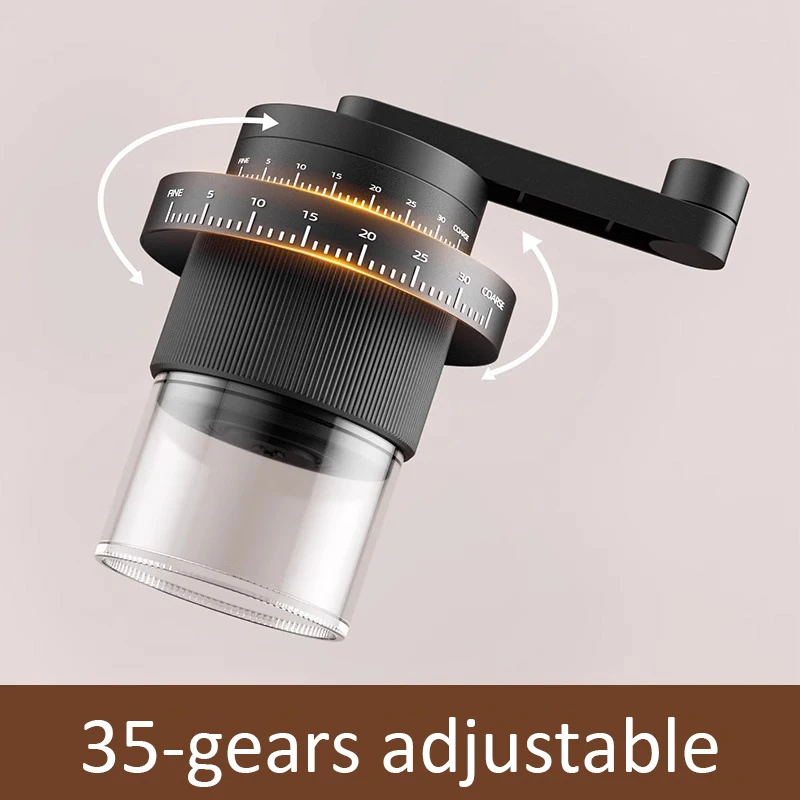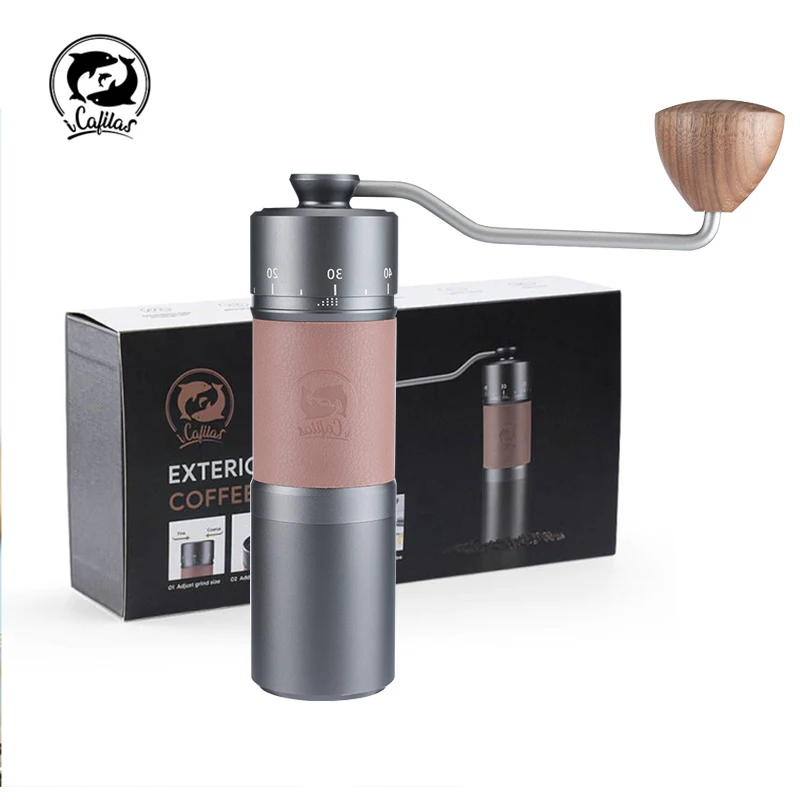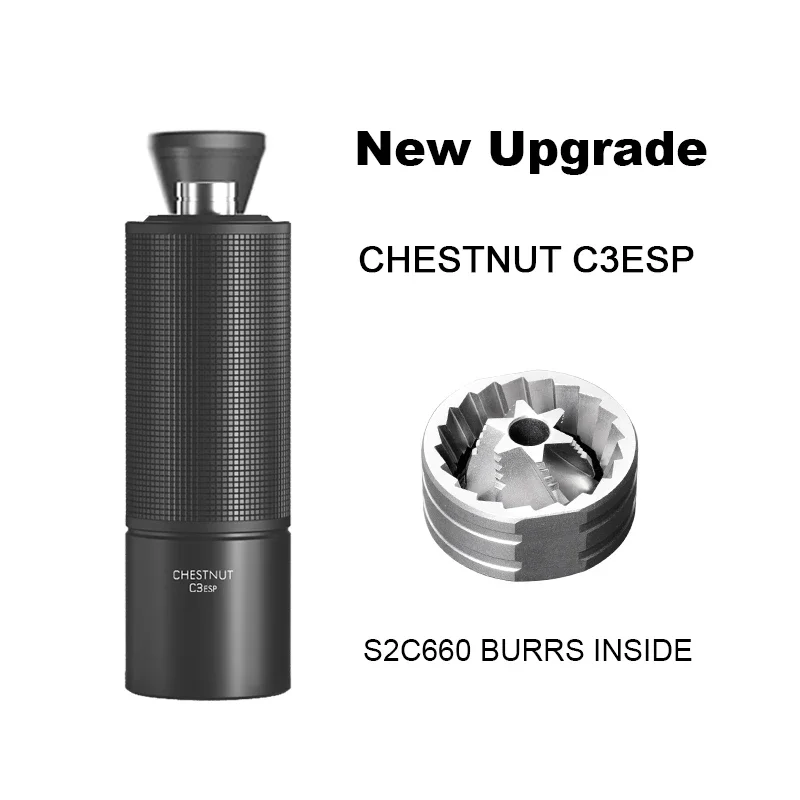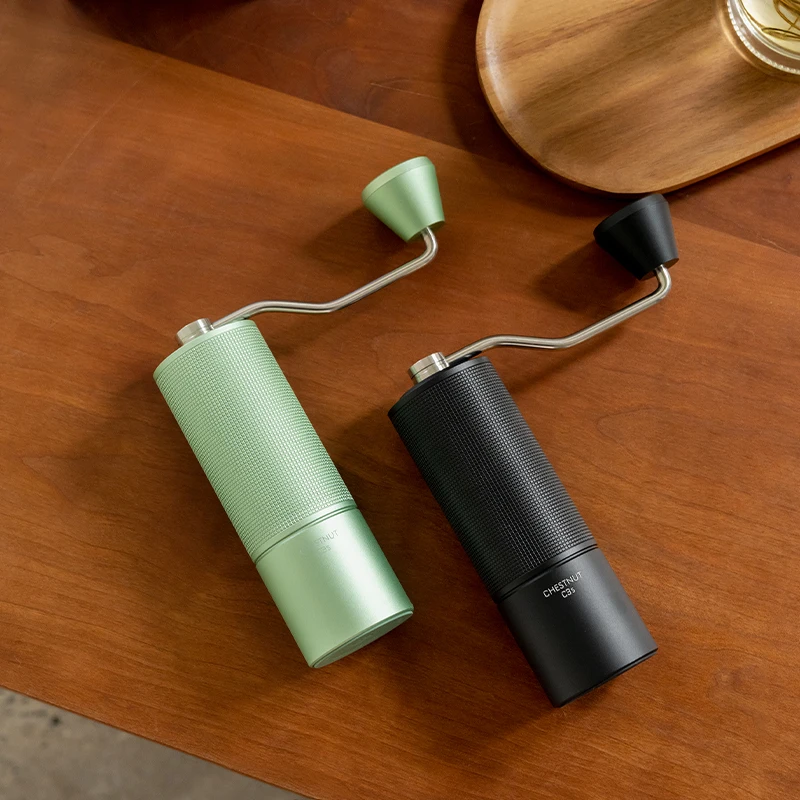Introduction: Understanding the Precision Engineering Behind Manual Flat Burr Grinders
Manual flat burr grinders represent the pinnacle of coffee grinding precision, distinguished from their electric counterparts and conical burr alternatives by their unique mechanical design. These devices feature two parallel, horizontally-oriented grinding plates (burrs) that crush coffee beans with exceptional consistency. Unlike blade grinders that chop beans randomly or conical burrs that funnel beans through a tapered grinding path, flat burr systems deliver uniform particle size through precise engineering.
Understanding the inner workings of these precision instruments isn’t just for the mechanically curious—it directly impacts your daily brewing results. The consistency of your coffee extraction depends heavily on the uniformity of ground particles, which is determined by the mechanical precision of your grinder’s components working in harmony. The fundamental principles of grinder mechanics create the foundation for exceptional coffee brewing.
In this comprehensive guide, we’ll examine the core components, forces, and design principles that make manual flat burr grinders function. From the initial bean hopper to the final collection chamber, we’ll explore how each element contributes to the grinding process. By the end, you’ll understand how tolerances measured to within 0.002 inches (0.05mm) directly impact what ends up in your cup.
Core Components: Essential Elements of a Manual Flat Burr Grinder System
Every manual flat burr grinder consists of several crucial components working together in a precision assembly. Each part serves a specific mechanical function that contributes to the overall grinding process:
Bean Hopper: The top container that holds whole beans before grinding, designed with gravity-fed angles to ensure consistent bean delivery to the burrs.
Grinding Chamber: The central compartment housing the burr set, typically constructed from robust materials like aluminum or stainless steel to maintain structural integrity during grinding.
Burr Set: The heart of the system, consisting of two disc-shaped grinding plates—one stationary (fixed burr) and one rotating (moving burr)—that must maintain perfect parallel alignment for consistent results.
Central Shaft/Axle: The critical component that transfers rotational force from the handle to the moving burr while maintaining precise alignment, typically machined to tolerances of 0.001-0.003 inches (0.025-0.075mm).
Bearing System: Precision components (usually ball bearings or bushings) that support the central shaft, minimize wobble, and reduce friction for smooth operation.
Adjustment Mechanism: The precision system that controls the distance between burrs, typically using threaded components that allow for minute adjustments that significantly affect particle size.
Handle and Crank Assembly: The user interface component that converts human power to rotational force, designed with mechanical advantage principles to minimize required effort.
Grounds Receptacle: The collection chamber designed to receive and contain ground coffee while minimizing static buildup and grounds retention.
The differences in component design between flat and conical systems illustrate important engineering tradeoffs, while examining examples of flat burr hand grinders with different component configurations reveals how manufacturers address these challenges.
Material selection significantly impacts performance, with high-quality models typically featuring hardened steel burrs rated between 58-60 HRC (Hardness Rockwell C scale) and precision bearing systems to maintain stability during operation.
Flat Burr Design: The Engineering Behind the Grinding Surface
The flat burr geometry represents a specific engineering approach to coffee grinding focused on particle uniformity. Unlike conical burrs that use angled surfaces, flat burrs employ two parallel discs with precisely machined cutting surfaces that face each other. This parallel alignment creates consistent shearing forces across the entire grinding surface.
The cutting teeth patterns on quality burrs follow specific geometric arrangements, typically either radial (teeth extending from center outward) or sectoral (teeth arranged in distinct segments). These patterns aren’t random—they’re engineered to provide optimal bean fracturing and particle movement through the grinding chamber. The specific design affects how beans are drawn between the burrs, how efficiently particles exit the grinding area, and ultimately the consistency of the final grind size.
Material science plays a critical role in burr performance. Most premium burrs use hardened tool steel (typically 58-60 HRC) offering exceptional wear resistance and edge retention. Ceramic alternatives, while corrosion-resistant, typically offer less precision in manufacturing tolerances. The surface finish of burrs requires meticulous production processes to ensure the cutting edges remain sharp while maintaining precise dimensions—often within 0.001 inches (0.025mm) tolerance.
The diameter of flat burrs significantly impacts grinding efficiency, with common sizes ranging from 1.2-2.2 inches (30-55mm). Larger burrs provide greater surface area and typically deliver faster grinding but require more force to turn. Understanding how flat burr design impacts particle uniformity helps explain why premium grinders command higher prices—the precision manufacturing required for optimal burr production necessitates sophisticated equipment and stringent quality control.

The Grinding Process Mechanics: From Whole Bean to Uniform Particles
The journey from whole bean to ground coffee involves a surprisingly complex mechanical process. When you turn the handle of a manual flat burr grinder, you initiate a sequence of precision interactions:
First, beans drop from the hopper into the grinding chamber through a small opening that regulates feed rate. This controlled introduction is crucial for consistent grinding—feeding too many beans simultaneously can cause uneven particle size or even stall the mechanism.
As beans enter the burr chamber, they encounter the outer edges of the rotating and stationary burrs. The initial fracture occurs here, breaking beans into large fragments. These fragments then travel inward between the burrs, experiencing progressively finer grinding as they move through the decreasing space between the parallel surfaces.
During this journey, three distinct forces act on the coffee particles:
1. Shearing forces that slice beans between passing edges
2. Crushing forces that compress beans between flat surfaces
3. Friction forces that further break down particles as they move through the chamber
The flat burr design creates a unique particle path that differs from conical burrs. Coffee particles must travel horizontally outward from the center toward the edges of the burr chamber, utilizing centrifugal force generated by rotation. This horizontal movement pattern affects how quickly particles exit the grinding chamber and influences retention (how much coffee remains trapped in the mechanism).
For optimal grinding consistency, most manual grinders operate best at 50-70 RPM—significantly slower than electric grinders. This reduced speed minimizes heat generation while maximizing the relationship between grinding mechanics and extraction uniformity. Various manual coffee burr grinder designs demonstrate different approaches to managing this particle flow.
A typical 0.7-ounce (20g) dose requires approximately 25-40 seconds of grinding, depending on burr size and desired fineness—a direct reflection of the mechanical efficiency of the system.
Adjustment Mechanisms: The Engineering of Precision Grind Control
The heart of any quality manual grinder lies in its adjustment system—the mechanical interface that precisely controls the distance between burrs. This seemingly simple function requires sophisticated engineering to achieve consistent results.
Most manual flat burr grinders utilize a threaded adjustment system where rotating a dial or collar moves one burr incrementally closer to or farther from its partner. The thread pitch (distance between threads) directly determines adjustment precision—finer threads allow for more minute adjustments but require more turns to make significant changes. Premium grinders typically feature thread pitches between 0.5-1.0mm, allowing adjustments as small as 0.004 inches (0.1mm) that dramatically impact particle size.
Two primary adjustment approaches exist in manual grinders:
Stepped Systems incorporate detents or “clicks” that provide tactile feedback and repeatable settings. These systems use precision-machined notches with a spring-loaded ball bearing or pin that locks into predetermined positions. High-quality stepped systems typically offer 30-50 distinct settings, balancing precision with usability.
Stepless Systems provide infinite adjustment possibilities without predetermined positions. These designs rely on continuous threaded mechanisms and friction to maintain settings. While offering greater fine-tuning capability, especially beneficial for espresso brewing, they can be more challenging to replicate precisely.
Both approaches must solve the same fundamental engineering challenge: maintaining the selected setting during the vibration and torque of grinding. Premium models incorporate locking mechanisms or high-friction materials that prevent unwanted adjustment drift while grinding.
The comparison of adjustment mechanisms in different grinder types highlights these engineering differences, while examining precision adjustment mechanisms in manual grinders reveals the diversity of solutions manufacturers have developed.
Burr Alignment Engineering: The Foundation of Grinding Consistency
Perhaps no aspect of manual grinder engineering is more crucial yet less visible than burr alignment. In flat burr systems, the grinding surfaces must maintain near-perfect parallelism to deliver consistent particle size. Even slight misalignment—as little as 0.002 inches (0.05mm)—can create uneven grinding that produces both overly fine particles and larger chunks simultaneously.
Achieving proper alignment depends on several integrated precision elements:
Shaft Straightness: The central axle must maintain perfect perpendicularity to the burr faces, typically machined to tolerances of less than 0.001 inches (0.025mm).
Bearing Precision: The bearings supporting the central shaft must minimize both axial play (up/down movement) and radial play (side-to-side wobble).
Mounting Surface Flatness: The surfaces where burrs attach must be perfectly flat to prevent tilting of the burr face.
Burr Manufacturing Precision: The burrs themselves must be manufactured with consistent thickness across their entire surface.
When alignment issues occur, the symptoms appear as inconsistent grind size—typically an excess of fine particles (“fines”) mixed with larger chunks. This directly impacts extraction, creating bitter over-extracted notes from the fines while simultaneously producing sour under-extracted flavors from the larger particles.
Premium manual grinders incorporate several engineering solutions to maintain alignment, including:
– Precision-machined mounting surfaces with tight tolerances
– Multiple bearing points to stabilize the central shaft
– Hardened materials that resist deformation under pressure
– Calibration systems that allow for user adjustment of alignment
These engineering details explain why higher-end manual grinders command premium prices—the manufacturing precision required significantly increases production costs.

Manual Power Transmission: Force Application and Mechanical Advantage
Converting human effort into effective grinding force involves careful engineering of the power transmission system. The handle and crank assembly serves as more than just a user interface—it’s a critical mechanical component that applies principles of torque and leverage.
The physics of manual grinding starts with the handle length, which directly determines mechanical advantage. Longer handles (typically 4-6 inches or 100-150mm) reduce the required force by increasing the leverage ratio, making grinding less strenuous. However, this mechanical advantage comes with tradeoffs—longer handles require more space and can make the grinder less portable.
When you turn the handle, you generate torque (rotational force) that travels through the central shaft to the rotating burr. A typical manual grinding session requires approximately 0.5-1.0 Newton-meters of torque—about the force needed to tighten a small bolt. However, this force must be sustained throughout the entire grinding process.
Several factors influence how efficiently this force transfers through the system:
Bearing Efficiency: Higher quality bearings reduce friction losses, allowing more of your input energy to reach the beans.
Shaft Rigidity: Stiffer, precisely machined shafts transmit torque more efficiently without flexing or absorbing energy.
Handle Connection: The interface between handle and shaft must eliminate play while maintaining smooth rotation.
The grinding resistance varies based on bean hardness, burr design, and grind setting. Finer settings create more resistance as the burrs move closer together, requiring more force from the user. This relationship between heat transfer in different power transmission systems explains why manual grinding generates less heat than electric alternatives.
Examining various handle and force transmission designs reveals different approaches manufacturers take to optimize this critical interaction between user and machine.
Flat vs. Conical Burrs: A Mechanical Engineering Comparison
The fundamental difference between flat and conical burr systems lies in their geometric approach to grinding. This geometric distinction creates cascading effects throughout the entire grinding mechanism.
Flat burrs consist of two parallel discs with cutting teeth on their opposing faces. Coffee beans enter from the center and work their way outward between these parallel surfaces. Conical burrs, conversely, use a cone-shaped inner burr that fits inside a ring-shaped outer burr, creating an angled grinding path where beans travel downward through progressively narrower spaces.
These different geometries create distinct mechanical characteristics:
Grinding Path: Flat burrs force particles to travel horizontally against gravity, requiring more mechanical energy to move grounds outward. Conical burrs utilize gravity to help move particles downward through the grinding path, requiring approximately 20% less force for similar results.
Contact Surface Area: Flat burrs typically offer greater total grinding surface area within the same physical size, potentially providing more cutting edges in contact with beans simultaneously.
Particle Distribution: Flat burrs tend to produce more uniform particle sizes (unimodal distribution), while conical burrs often create a bimodal distribution with two distinct particle size peaks—a characteristic that affects extraction differently.
Heat Generation: Flat burrs generally generate more heat due to their larger surface contact area and horizontal particle movement that creates more friction.
Alignment Sensitivity: Flat burrs are more sensitive to alignment issues due to their parallel-surface design, while conical burrs can tolerate slightly more misalignment without dramatically affecting grind quality.
These mechanical differences explain why certain brewing methods may benefit from specific burr types. Understanding how burr geometry affects espresso extraction provides valuable insight for those seeking maximum control over their brewing variables.
Fine Adjustment Hand Grinder, Precision Manual Grinder, Travel Coffee Grinder
Price range: $185.11 through $494.63 Select options This product has multiple variants. The options may be chosen on the product pageHand Burr Grinder, Hand Crank Coffee Grinder, Manual Espresso Grinder, Portable Coffee Grinder
Price range: $262.72 through $300.22 Select options This product has multiple variants. The options may be chosen on the product pageManual Burr Mill, Manual Coffee Grinder Stainless Steel, Manual Coffee Mill Grinder, Mechanical Coffee Grinder
Price range: $127.26 through $130.32 Select options This product has multiple variants. The options may be chosen on the product pageHand Burr Grinder, Manual Coffee Grinder Stainless Steel, Precision Manual Grinder
Price range: $183.64 through $187.52 Select options This product has multiple variants. The options may be chosen on the product page
Material Engineering: Critical Design Decisions in Grinder Construction
Material selection in manual grinder construction balances multiple competing factors: durability, weight, cost, thermal properties, and aesthetic considerations. These choices significantly impact both performance and user experience.
The grinder body materials establish the structural framework and significantly affect overall weight and durability:
Aluminum: Offers excellent strength-to-weight ratio, good thermal conductivity, and resistance to corrosion. Premium models often use aircraft-grade aluminum (6061-T6) for its superior mechanical properties.
Stainless Steel: Provides maximum durability and stability but adds significant weight. Common in premium models where grinding stability takes priority over portability.
Polymers/Plastics: Used in budget-oriented models, offering reduced weight and cost but typically less durability and stability during grinding.
Burr materials represent perhaps the most critical material decision:
Tool Steel: Most premium burrs utilize high-carbon tool steels (like 440C stainless or equivalent) hardened to 58-60 HRC. This hardness maintains sharp cutting edges over thousands of grinding cycles.
Ceramic: Offers extreme hardness and corrosion resistance but tends to be more brittle and typically offers less precision in manufacturing tolerances.
Bearing selection significantly impacts both feel and longevity:
Ball Bearings: Provide minimal friction and precise shaft control but add cost and complexity.
Bushings: Simpler and less expensive but generate more friction and typically wear faster over time.
The implications of material choices on grinder performance extend beyond just durability—they affect everything from grinding stability to heat transfer during operation. For instance, metal bodies conduct and dissipate heat more effectively than plastic alternatives, potentially protecting flavor compounds in the coffee.
Weight distribution, particularly in the base, impacts stability during grinding. Many premium models concentrate mass in the lower portion to minimize movement during operation, allowing users to maintain more consistent grinding motion.

Advanced Considerations: Specialized Engineering Elements
Beyond the fundamental components, several specialized engineering considerations distinguish exceptional manual grinders from adequate ones. These refinements often separate entry-level from premium offerings in the Savor Suite collection.
Vibration dynamics play a crucial role in grinding consistency. Every rotating mechanism generates vibrations that can affect particle size uniformity. Premium grinders incorporate damping features to minimize these vibrations:
– Precisely balanced rotating assemblies to reduce oscillation
– Rubber or silicone damping elements at strategic contact points
– Increased mass in the base to absorb vibration energy
Static electricity management addresses a common frustration in coffee grinding. The friction between coffee particles and grinder surfaces generates static charges that cause grounds to cling to components. Advanced designs incorporate:
– Anti-static materials in grounds collection chambers
– Grounding paths that dissipate electrical charges
– Textured surfaces that minimize contact area and static buildup
Axial and radial play refers to unwanted movement in the central shaft. Premium manual grinders typically restrict this movement to less than 0.002 inches (0.05mm) through:
– Multiple precision bearings supporting critical rotation points
– Tight manufacturing tolerances in shaft and housing dimensions
– Pre-loaded bearing systems that eliminate play while maintaining smooth rotation
Heat dissipation considerations become important during extended grinding sessions. While manual grinders generate significantly less heat than electric models, premium designs still incorporate:
– Materials with good thermal conductivity to draw heat away from burrs
– Increased mass that serves as a heat sink
– Ventilation designs that allow air circulation around critical components
A quality burr set in a well-maintained manual grinder can process 1,000-1,500 pounds (450-680kg) of coffee before requiring replacement—representing decades of typical home use.
DIY Understanding: How Mechanical Knowledge Improves Your Grinding Experience
Understanding the mechanical principles behind your manual grinder transforms you from a mere user into an informed operator capable of maximizing performance and extending equipment life.
This knowledge provides practical benefits for daily use:
Troubleshooting: Recognizing mechanical symptoms helps identify issues before they affect your coffee. For example, a rhythmic resistance pattern while turning the handle typically indicates a burr alignment problem, while sudden free spinning might suggest stripped threads in the adjustment mechanism.
Maintenance optimization: Understanding component interactions helps prioritize maintenance efforts. Keeping the central shaft clean and lightly lubricated (with food-safe lubricant) significantly reduces wear on bearings and threading—extending grinder life substantially.
Performance evaluation: Mechanical knowledge provides objective criteria for assessing grinder quality. When comparing models, you can focus on bearing quality, shaft stability, and adjustment precision rather than marketing claims.
Setting adjustments: Understanding the mechanical relationship between adjustment settings and particle size helps you make more precise changes for different brewing methods. For example, knowing that each “click” on a stepped adjustment typically represents about 0.004 inches (0.1mm) of burr movement helps calibrate your expectations for how dramatically a single adjustment will affect your brew.
Comprehensive practical application of mechanical knowledge for maintenance improves both immediate grinding results and long-term equipment performance. This mechanical understanding transforms a morning ritual into a precision operation that consistently delivers optimal brewing results.
Manual vs. Electric Grinder Mechanics: Key Engineering Differences
The fundamental distinction between manual and electric grinders extends far beyond the power source—it influences the entire mechanical design approach and resulting coffee quality.
Manual grinders typically operate at 50-70 RPM during normal use, while electric grinders spin at 400-1200 RPM. This speed difference dramatically affects several aspects of grinding:
Heat generation: The slower rotation of manual grinders produces significantly less friction and heat. Since heat can volatilize aromatic compounds and accelerate oxidation of coffee oils, this lower temperature helps preserve delicate flavor components.
Torque characteristics: Manual grinding provides variable torque based on user input—automatically adjusting to bean density and hardness. Electric motors maintain consistent torque regardless of resistance, which can sometimes lead to overheating or stalling when encountering particularly dense beans.
Adjustment precision: Manual grinders typically offer more precise adjustment capabilities since they don’t need to accommodate motor vibration and can utilize finer threading systems. Electric grinders must engineer around motor movement, often requiring more robust (and less precise) adjustment mechanisms.
Mechanical complexity: Manual grinders contain fewer components and failure points. Without motors, circuit boards, and power transmission systems, they often demonstrate greater longevity—sometimes lasting decades with proper maintenance.
These mechanical differences explain why many coffee enthusiasts maintain separate grinders for different purposes: electric for daily convenience and manual for precision brewing methods where flavor preservation and grind consistency are paramount.
Is Burr Alignment More Critical in Flat or Conical Grinders?
Burr alignment is significantly more critical in flat burr grinders than in conical designs. This difference stems directly from their geometric configuration and how beans interact with the grinding surfaces.
In flat burr designs, the entire grinding action depends on two precisely parallel surfaces maintaining consistent distance across their full diameter. Any deviation from perfect parallelism—even as small as 0.001-0.002 inches (0.025-0.05mm)—creates an uneven gap that produces inconsistent particle sizes. One section might grind too fine while another remains too coarse.
Conical burr designs are more forgiving of minor alignment issues because:
1. The angled grinding surfaces naturally guide beans toward the narrowest point
2. The cone shape provides a progressive reduction in size rather than relying on perfectly parallel surfaces
3. The alignment is primarily axial (up/down) rather than requiring perfect parallelism
This alignment sensitivity explains why high-quality flat burr grinders typically cost more—they require more precise manufacturing tolerances and often incorporate additional stabilizing features to maintain alignment during use. For users seeking maximum consistency, understanding these alignment differences helps explain why premium flat burr grinders command higher prices and deliver noticeably more uniform results when properly maintained.
How Do High-End Manual Grinders Achieve Greater Stability?
Premium manual grinders incorporate several engineering solutions to maximize stability during operation—a critical factor for grind consistency:
Advanced bearing arrangements represent a primary stability enhancement. While budget grinders typically use single bearings or bushings, high-end models often feature dual bearing systems that control both axial and radial movement. Some premium models utilize ceramic hybrid bearings that combine stainless steel races with ceramic balls for maximum precision and longevity.
Shaft design refinements significantly impact stability. Premium grinders typically feature thicker central shafts (often 8-10mm vs. 5-6mm in budget models) manufactured from hardened steel with tight dimensional tolerances. These more substantial shafts resist flexing during grinding, maintaining more consistent burr alignment.
Material mass distribution plays a crucial role in dampening vibration. High-end grinders strategically concentrate weight in the base and around the grinding chamber, using materials like stainless steel or brass to provide inertial stability that resists movement during grinding.
Manufacturing precision represents perhaps the most significant difference. Premium grinders typically maintain tolerances of 0.001-0.002 inches (0.025-0.05mm) throughout the drive train components, while budget models might allow 2-3 times greater variance. This precision directly translates to more consistent grind results and longer component life.
What Are the Most Common Mechanical Failure Points in Manual Grinders?
Understanding potential failure points helps users prioritize maintenance and make informed purchasing decisions:
Bearing wear represents the most common long-term issue in manual grinders. Bearings support the central shaft and handle continuous load during grinding. Early signs of bearing wear include increased resistance, inconsistent turning feel, or audible grinding noises during operation. Premium bearings typically last 5-10 years under normal use, while basic bearings may show wear within 1-2 years.
Burr dulling occurs gradually over extended use. While quality hardened steel burrs maintain effectiveness for processing 1,000-1,500 pounds (450-680kg) of coffee, they eventually lose their sharp cutting edges. Signs include increased grinding time, more inconsistent particle size, and greater effort required. Ceramic burrs typically maintain sharpness longer but are more vulnerable to damage from foreign objects.
Adjustment mechanism wear affects grinding precision over time. The threads that control burr distance gradually wear, introducing play or inconsistency in settings. Premium grinders with hardened steel threads show minimal wear even after years of use, while grinders with aluminum or brass threading components may develop noticeable play within a few years of regular use.
Handle connection failures typically result from excessive force or material fatigue. The interface between handle and central shaft experiences significant torque during grinding. Signs of developing problems include wobbling, clicking, or slipping during operation. Most connection failures are preventable through avoiding excessive force and ensuring the grinder is clean and properly maintained.
Regular maintenance—particularly keeping the mechanism clean and properly lubricated with food-safe lubricants—significantly extends the useful life of all components.







